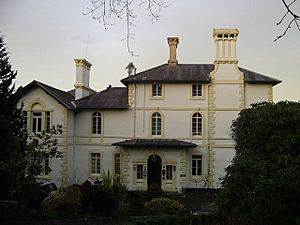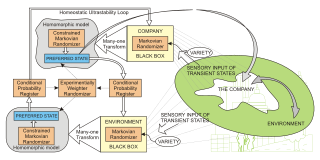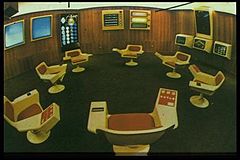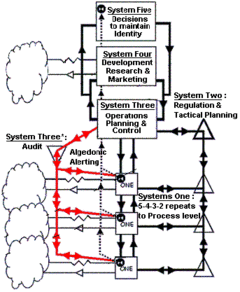Stafford Beer facts for kids
Quick facts for kids
Stafford Beer
|
|
|---|---|
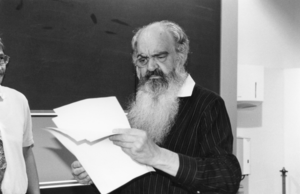
Stafford Beer (1990)
|
|
| Born |
Anthony Stafford Beer
25 September 1926 |
| Died | 23 August 2002 (aged 75) |
| Nationality | British |
| Occupation | Theorist, consultant and professor |
| Known for | Operational research, management cybernetics |
Anthony Stafford Beer (born September 25, 1926 – died August 23, 2002) was a smart British thinker, advisor, and professor. He taught at the Manchester Business School. He is famous for his work in two areas: operational research and management cybernetics. These big words mean he studied how to make organizations work better and how systems control themselves.
Contents
Biography
Early life and army service
Stafford Beer was born in Putney, London, in 1926. His father was a chief statistician, which means he worked with numbers and data. Stafford went to Whitgift School but left at 17. He then started studying philosophy at University College London.
In 1944, he joined the army during World War II. He served in India until 1947. After the war, he worked in a special group that used science to solve army problems. This was called Operations research. By 1949, he had become a captain.
When he was about 21, he decided to stop using his first name, Anthony. He preferred to be called Stafford.
Working with companies
In 1956, Stafford Beer joined a company called United Steel. He convinced them to start a new group focused on "operational research" and "cybernetics." This group used a special computer, the Ferranti Pegasus, to help manage the company better.
In 1961, he left United Steel to start his own company called SIGMA. It was a consulting firm that helped other businesses use science to improve their operations. Later, he worked for a big publishing company before becoming an independent consultant. He became very interested in how social systems work.
Project Cybersyn
In 1971, Stafford Beer was asked to help the government of Chile. They wanted to use his ideas about cybernetics to manage the country's economy. This led to a project called Cybersyn.
The goal of Cybersyn was to use computers and a communication network to help the government manage factories and businesses. It aimed to increase production while still letting workers and managers have their own freedom. The system used about 500 telex machines (like old-fashioned email) in factories and government offices. These machines sent information to a main computer in Santiago. The computer would then show important information and help leaders make decisions.
The project was very advanced, but it stopped in 1973 after a change in the Chilean government. Even after this, Beer continued to advise governments in other countries like Mexico, Uruguay, and Venezuela.
Later life and teaching
In the mid-1970s, Stafford Beer moved to Wales. He became very interested in poetry and art. He also spent part of the year in Toronto, Canada. He was a visiting professor at nearly 30 universities and received many special degrees. He also led the World Organization of Systems and Cybernetics.
Falcondale Collection
In 1994, Stafford Beer taught a special course at the Falcondale Hotel in Lampeter. Nine of these teaching sessions were recorded as videos. They are now known as the Falcondale Collection and can be found online. The sessions covered topics like art, science, and philosophy, and how cybernetics could be used in society, government, and business.
Family life
Stafford Beer was married twice and had five sons and two daughters. His partner for the last 20 years of his life was Allenna Leonard, who also studied cybernetics. One of his daughters, Vanilla Beer, is an artist.
Work
Management cybernetics
Stafford Beer was the first person to use the idea of "cybernetics" for managing organizations. He said that cybernetics is the "science of effective organization." In the 1960s and 1970s, he wrote a lot about this topic.
He created something called the viable system model. This model helps to find problems in how an organization is set up. It's like a blueprint for how any successful system should work to survive and adapt.
Project Cybersyn details
As mentioned, Stafford Beer was deeply involved in the Cybersyn project in Chile. This project aimed to use his cybernetic ideas to manage the country's economy. The main idea was to create a network of computers and communication tools. This network would help the government manage the state-run businesses.
At the heart of the project was a special operations room. Here, government managers could see important information about the economy in real-time. They could then make plans and send advice to managers in factories. The system used about 500 telex machines to collect information from businesses. This data was sent to a main computer. The computer would then use special software to model the economy and flag any problems. The project was very advanced for its time, but it was stopped by a political change in 1973.
Viable System Model (VSM)
The Viable System Model (VSM) is a way to understand how any successful organization or system is built. A "viable system" is one that can survive and change in a changing world. A key part of systems that survive is that they can adapt. The VSM shows how a system can be organized to be independent and able to adapt.
Syntegration and Team Syntegrity
Syntegrity is a special way to solve problems without a boss telling everyone what to do. Stafford Beer created this model in the 1990s. It can be used by a small team of 10 to 42 people. It's a method that businesses use to work together better. The name comes from "synergistic" (meaning working together for a greater effect) and "tensegrity" (a type of structure).
POSIWID
Stafford Beer often used the phrase POSIWID. It stands for "the purpose of a system is what it does." This means that what a system actually does is its real purpose, even if its official purpose is different. For example, a school's official purpose might be to educate, but if it mainly focuses on sports, then its real purpose (what it does) might be to produce athletes. Beer believed this idea helps us understand systems better.
Awards
Stafford Beer received many awards for his work. These included awards from the Royal Swedish Academy of Engineering Sciences, the United Kingdom Systems Society, and the American Society for Cybernetics.
Literature
Stafford Beer wrote many important books and articles about cybernetics and management. Some of his well-known books include Cybernetics and Management, Brain Of The Firm, and Designing Freedom.
- Audio
- 1973, Stafford Beer. "Designing Freedom" The 1973 Massey Lectures RADIO CANADA INTERNATIONAL TRANSCRIPTION: E1121 "The Real Threat to all We Most Dear",E1122 "The Disregarded Tools of Modern Man",E1123, "A Liberty Machine in Prototype" E1124, "Science in The Service of Man" 1h 53:30.
- 1990, Stafford Beer, "Forty Years of Cybernetics", Gordon Hyde Memorial Lecture at the Cybernetics Society in London, January 1990 (audio file: 1hr 27mins).
- Video
- 1990, Stafford Beer, Stafford Beer at Monterrey Tec, March 1990 illustrated by Javier Livas
- About Stafford Beer
- 1994, Harnden, R and Leonard, A. (Eds.), How Many Grapes Went into the Wine: Stafford Beer on the Art and Science of Holisitic Management; John Wiley, Chichester.
- 2002, Rosemary Bechler and Rob Passmore, "Stafford Beer: the man who could have run the world", openDemocracy, 7 November 2002
- 2003, Whittaker, David, Stafford Beer: A Personal Memoir; (Includes an interview with Brian Eno) Wavestone Press, Charlbury
- 2004, "Ten pints of Beer: The rationale of Stafford Beer's cybernetic books (1959‐94)", Kybernetes, Vol. 33 No. 3/4, pp. 828–842. https://doi.org/10.1108/03684920410523724
- 2006, Jonathan Rosenhead, "IFORS' Operational Research Hall of Fame Stafford Beer", in International Transactions in Operational Research Vol 13, nr.6, pp. 577–581.
- 2009, Whittaker, David, (Ed.) Think Before you Think: Social Complexity and Knowledge of Knowing; (Selected writings of Stafford Beer with life chronology), Foreword by Brian Eno, Wavestone Press, Charlbury


